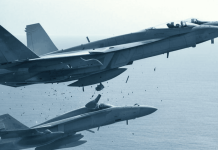Russia conducted extensive military drills in the Baltic to master anti-submarine warfare. Tensions continue to grip the region as the Baltic Sea is turning into a ‘NATO lake’ after Sweden’s induction into the military alliance.
The crew of the patrol ship “Neustrashimy” and the corvettes “Soobrazitelny,” “Boykiy,” and “Stoikiy,” along with the fleet’s Ka-27 anti-submarine helicopters, recently carried out a comprehensive exercise in the Baltic Sea to locate, track, and “destroy” a fictitious enemy submarine.
The exercise featured an enemy submarine that was tasked with destroying the fleet’s group of ships while hiding close to one of the Baltic Fleet’s naval groups. The “Varshavyanka” class diesel-electric submarine reportedly served as the mock enemy.
The fleet sent its ships and anti-submarine helicopters to the specified maritime sector to address this “intruder.” The helicopter crews used sophisticated hydroacoustic detecting technologies to locate the target and communicated the submarine’s coordinates to the Baltic Fleet’s corvettes.
The operation was declared successful after the ships neutralized the “enemy” submarine using torpedo weapons.
The Central Marine Design Bureau “Almaz” produced the multipurpose Project 20380 corvettes known as “Boykiy,” “Stoikiy,” and “Soobrazitelny.”
These vessels are outfitted with various weaponry, including automatic artillery mounts, supersonic missiles, anti-aircraft missiles, and artillery complexes, as well as adaptable artillery systems, to enable them to perform patrol and surveillance operations, escort missions, and strike missions in coastal zones. They are also capable of accommodating the Ka-27 anti-submarine chopper.
In another instance, the corvettes successfully fired artillery and surface-to-air missiles against imaginary enemy aerial targets as part of their Baltic drills.
🇷🇺 🛩 Flight-tactical exercises for naval aviation helicopter crews have begun in the Baltic Fleet
About 20 crews of attack and military transport helicopters Mi-24 and Mi-8, as well as naval helicopters Ka-29, Ka-27 and Ka-27PS are participating in the maneuvers in the… pic.twitter.com/OfSfvUcaL0
— Zlatti71 (@djuric_zlatko) March 12, 2024
While the corvettes Boiky, Stoiky, and Soobrazitelny fired artillery guns from A-190 and AK-630 to target enemy aircraft, the frigate Neustrashimy successfully fired from a Kinzhal seaborne surface-to-air missile system. The firings were done against special illumination shells and simulated aerial targets.
According to the Baltic Fleet’s press office, combat teams from the warships’ radio-technical, missile, and artillery combat units honed their interoperability to locate, identify, and track targets using radio-technical equipment to destroy them during the maneuvers.
#UkraineRussiaWar #Robotyne#Putin #Bakhmut #Kherson #Patriot
Russian Tu-22M3 bomber with Kh-22/32 missile and MiG-31 with Kh-47M2 "Kinzhal" flew over neutral waters in the Baltic and Caspian seas
During the flight, the Tu-22M3 were intercepted by an F/A-18C fighter… pic.twitter.com/CT57BXpDfU
— Koba (@Roberto05246129) March 13, 2024
The Russian Ministry of Defense (MoD) also announced on March 12 that Tu-22M3 long-range bombers and a MiG-31 fighter armed with the Kinzhal system performed scheduled flights over the Baltic and Caspian seas.
“Long-range aircraft of the Russian Aerospace Forces have performed scheduled flights over the international waters of the Baltic and Caspian seas. The mission involved Tu-22M3 long-range bombers and MiG-31 fighters armed with the Kinzhal air-launched system. The crews of MiG-31 aircraft practiced in-flight refueling,” it said.
These drills and scheduled flights over the Baltic are routine for the Russian military. However, the timing of the latest set of drills coincides with escalating tensions in the Baltic region following Sweden’s induction into the NATO Alliance and the accompanying rhetoric that claims the sea has been taken over by the alliance and pushed Russia to the fringes.
Baltic Sea’s NATO Takeover
Despite warnings from Russia, Sweden officially became a member of NATO last week, completing the alliance’s virtually total encirclement of the Baltic Sea, which is home to one of Russia’s fleets and a major oil trade route.
Latvia’s foreign minister and a self-declared candidate to head NATO, Krišjānis Kariņš, said, “The Baltic Sea becomes a Nato lake.”
After the US-led Western alliance started referring to the Baltic Sea as a “NATO lake,” indicating their strategic solidarity against what they saw as Moscow’s military belligerence after the 2014 Donbas war, the sea became a significant flashpoint. That rhetoric has been greatly heightened by Sweden’s entry into the bloc, leading to the decision to defend and militarize its strategically located island in the Baltic from Moscow.
Baltic Sea officially a NATO lake now. Congratulations Sweden! 🇸🇪 pic.twitter.com/o3NymwLh4i
— Maria Avdeeva (@maria_avdv) March 7, 2024
Until recently, the Suwałki Gap—a precarious 100-kilometer stretch that divides Poland from the Baltics—would have been the primary route for obtaining supplies and reinforcements for Estonia, Latvia, and Lithuania in the event of a conflict with Russia. However, that has now changed with Sweden’s induction since it brings with itself a crucial island called Gotland, which is less than 200 kilometers from Latvia.
Gotland is believed to be crucial to the security of the Baltic and, by extension, the NATO alliance. You can read a detailed report on Gotland’s strategic importance here.
“It reduces the vulnerability of the Baltics through only the Suwałki Gap. The entire security of the region is made stronger because it makes the eastern Baltic less vulnerable,” said Kariņš.
For this reason, Russia firmly opposed Sweden’s membership in NATO. In days leading to Hungary’s ratification of Sweden’s NATO membership, Russia said it would take unspecified military-technical and other countermeasures to protect it.

Experts believe that Sweden’s membership of NATO will significantly bolster its combat capability because Sweden’s world-class submarine fleet, which includes some of the most sophisticated conventional submarines ever constructed, will prove essential to keeping the seas open during hostilities.
That must explain Russia’s alacrity in conducting military drills, including anti-submarine missions in the region.
This appears to be in line with Russian President Vladimir Putin’s announced intentions to restructure his country’s armed forces and bolster Russian presence in the region to “neutralize threats” that he claimed stemmed from the NATO membership of Sweden and Finland.
- Contact the author at sakshi.tiwari9555 (at) gmail.com
- Follow EurAsian Times on Google News




